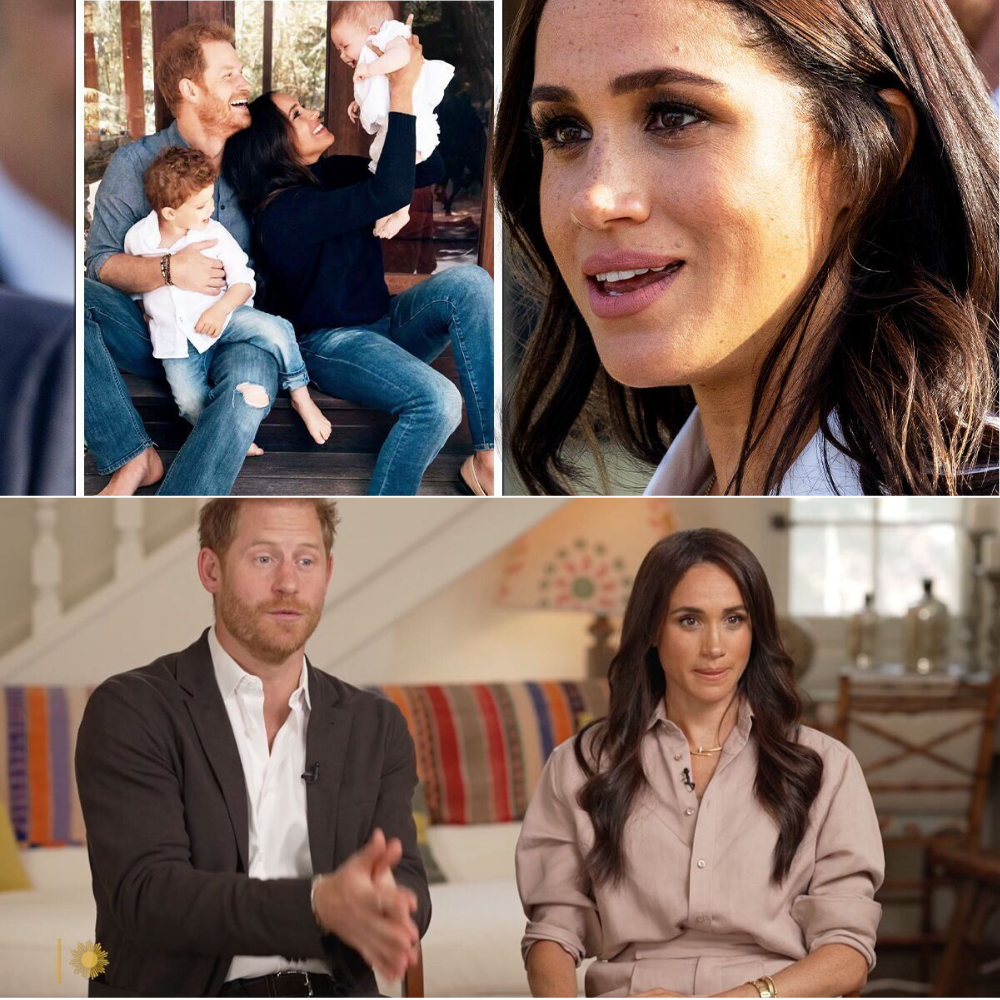
Meghan Markle, the Duchess of Sussex, has found herself at the center of a complex narrative that intertwines her past as a working royal with her current aspirations as a mother. Since stepping back from royal duties in 2020, Meghan and her husband, Prince Harry, have sought to carve out a new life in Montecito, California, far from the rigid protocols of Buckingham Palace. Their primary focus has been raising their two children, Prince Archie, born in 2019, and Princess Lilibet, born in 2021, in an environment that prioritizes normalcy over royal pomp. Yet, their efforts have not been without challenges, as public scrutiny and lingering ties to the royal family continue to cast a shadow over their plans. This article explores Meghan’s pursuit of a grounded life for her children, the obstacles she faces, and why her journey resonates with millions worldwide.
A New Chapter in Montecito
When Meghan and Harry relocated to the United States, their goal was clear: to provide Archie and Lilibet with a life unburdened by the expectations placed on royal heirs. In Montecito, a serene coastal enclave, the couple has embraced a lifestyle that contrasts sharply with their time in the United Kingdom. Their sprawling estate offers ample space for the children to play, and the family is often spotted engaging in everyday activities like visiting local farmers’ markets or strolling along the beach. For Meghan, who grew up in Los Angeles and navigated a successful career as an actress before joining the royal family, this return to California represents a homecoming of sorts—a chance to raise her children in a familiar, less formal setting.
The couple’s decision to step away from royal life was driven by a desire to shield their family from the intense media scrutiny they faced in the UK. In interviews, Harry has spoken candidly about his concerns for his children’s well-being, emphasizing the importance of protecting them from the pressures of public life. Meghan, too, has expressed her commitment to fostering a sense of normalcy, whether through enrolling Archie in a local preschool or celebrating Lilibet’s milestones in the privacy of their home. These efforts reflect a deliberate shift toward prioritizing family over tradition, a choice that has both inspired and polarized observers.
The Weight of a “Traumatized Dynamic”
Despite their intentions, Meghan and Harry remain tethered to the royal family’s complex history. The couple’s departure from royal duties, often referred to as “Megxit,” was marked by public disputes, including allegations of mistreatment by the royal institution and strained relationships with senior royals. These tensions have fueled a narrative that some describe as a “traumatized dynamic,” a cycle of public criticism and personal challenges that Meghan, in particular, struggles to escape. As a biracial American who entered the monarchy as an outsider, Meghan faced unique pressures, from racial bias in media coverage to rigid expectations of royal behavior. Her efforts to redefine her role within the family were met with resistance, contributing to the couple’s decision to seek independence.
This dynamic continues to shape public perceptions of Meghan’s parenting choices. Critics argue that her high-profile projects—such as her Netflix docuseries, her Archewell Foundation, and her lifestyle brand, American Riviera Orchard—undermine her claims of seeking a “normal” life. Others contend that these endeavors are a natural extension of her desire to build a legacy for her children, one rooted in philanthropy and creative freedom rather than royal obligation. The duality of Meghan’s public and private personas creates a paradox: she is both a global figure advocating for change and a mother striving to give her children an ordinary upbringing.
Parenting in the Public Eye
Raising children under public scrutiny is no small feat, and Meghan and Harry have taken deliberate steps to protect Archie and Lilibet’s privacy. Unlike their cousins, Prince George, Princess Charlotte, and Prince Louis, who frequently appear at official royal events, Archie and Lilibet lead largely private lives. The couple rarely shares photos of their children, and when they do, the images are carefully curated to avoid revealing too much. This approach stems from Harry’s own experiences growing up in the spotlight, as well as Meghan’s determination to prevent her children from becoming fodder for tabloid speculation.
Yet, the couple’s efforts to maintain privacy are complicated by their public profiles. Their media ventures, including Harry’s memoir Spare and their Netflix series, have invited criticism for exposing personal details about the royal family while simultaneously demanding privacy for their own children. Some observers question whether Archie and Lilibet can truly lead “normal” lives when their parents remain global celebrities. Others praise Meghan and Harry for setting boundaries, arguing that their transparency about their struggles helps destigmatize mental health and family challenges.
Building a Legacy for Archie and Lilibet
At the heart of Meghan’s vision is a desire to create a meaningful future for her children. Through Archewell, the couple has launched initiatives focused on mental health, gender equity, and community support, reflecting values they hope to instill in Archie and Lilibet. Meghan’s American Riviera Orchard, a lifestyle brand featuring home goods and culinary products, is another avenue for her to model entrepreneurship and creativity. These projects suggest that Meghan views “normalcy” not as anonymity but as the freedom to pursue one’s passions without institutional constraints.
The couple’s emphasis on philanthropy also extends to their parenting. Archie and Lilibet are being raised with an awareness of social issues, from environmental conservation to racial justice, topics that align with their parents’ advocacy. While the children are still young, Meghan and Harry have expressed their intention to involve them in charitable work as they grow, fostering a sense of purpose that transcends their royal titles. This approach contrasts with the traditional royal upbringing, which often prioritizes duty over personal fulfillment.
The Global Fascination with Meghan’s Journey
Meghan’s pursuit of a normal life for her children has sparked widespread debate, reflecting broader societal questions about identity, privilege, and parenting. For some, her story is a testament to resilience—a woman who faced adversity within one of the world’s most traditional institutions and emerged determined to chart her own path. Others view her actions as contradictory, questioning how a family that commands global attention can claim to seek normalcy. This dichotomy fuels the public’s fascination, as Meghan’s every move is dissected for clues about her intentions.
The conversation is further amplified by the couple’s connection to the royal family. While Archie and Lilibet are unlikely to undertake royal duties, their titles as prince and princess link them to a monarchy that remains a global institution. The decision to use these titles, confirmed in 2023, has reignited debates about whether Meghan and Harry are truly distancing themselves from the royal brand. Supporters argue that the titles are the children’s birthright, while critics see them as a strategic move to maintain relevance.
Challenges and Criticisms
Meghan’s efforts have not been without detractors. Some commentators suggest that her focus on privacy is selective, pointing to the couple’s media deals as evidence of a desire for attention. Others argue that the “traumatized dynamic” narrative is partly self-inflicted, stemming from the couple’s public criticisms of the royal family. These critiques highlight the difficulty of balancing personal authenticity with public perception, a challenge that Meghan navigates with varying degrees of success.
Additionally, the couple’s lifestyle in Montecito, with its multimillion-dollar estate and A-list connections, is far from ordinary by most standards. This disparity fuels skepticism about their claims of normalcy, as critics question whether Archie and Lilibet can relate to everyday experiences when surrounded by wealth and privilege. Meghan and Harry counter this by emphasizing their commitment to grounding their children through hands-on parenting and community engagement, but the perception gap remains.
A Vision for the Future
As Meghan and Harry continue to build their lives in California, their focus remains on creating a stable, nurturing environment for Archie and Lilibet. Meghan’s journey reflects a broader shift in how public figures approach parenting, blending personal ambition with a commitment to family. By prioritizing their children’s emotional well-being and exposing them to diverse perspectives, the couple is redefining what it means to raise royals in the modern era.
The road ahead will likely bring new challenges, from navigating media scrutiny to addressing questions about their children’s roles in the royal family. Yet, Meghan’s determination to provide Archie and Lilibet with a “normal” life—however she defines it—underscores her resilience and vision. Her story resonates because it touches on universal themes: the desire to protect one’s children, the struggle to overcome past wounds, and the courage to forge a new path in the face of adversity.
Why It Matters
Meghan Markle’s quest for normalcy is more than a personal endeavor; it’s a cultural moment that challenges traditional notions of royalty, privilege, and motherhood. Her ability to navigate a “traumatized dynamic” while building a future for Archie and Lilibet captivates audiences because it reflects the complexities of modern life. Whether you view her as a trailblazer or a polarizing figure, her story invites reflection on what it means to seek normalcy in an extraordinary world. As she continues to shape her family’s legacy, Meghan’s journey will remain a source of inspiration and debate for years to come.





